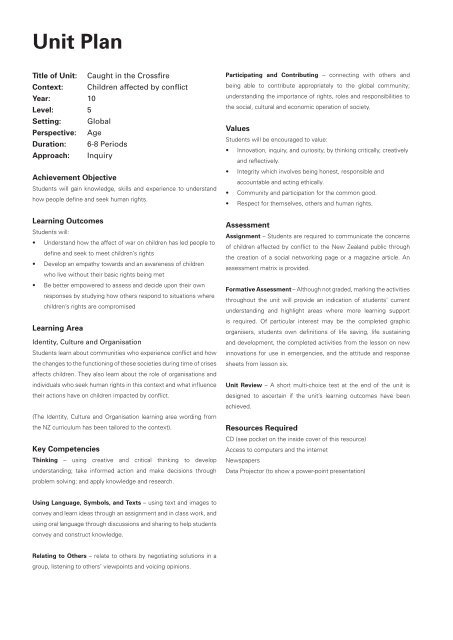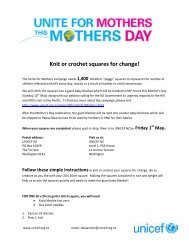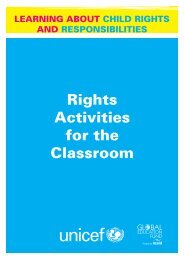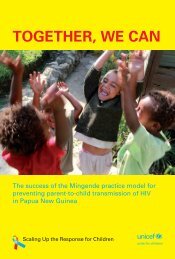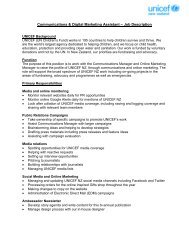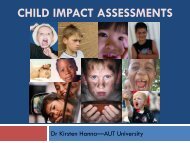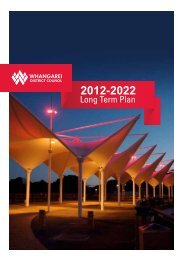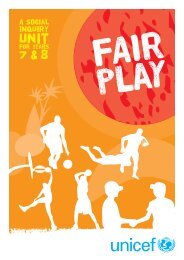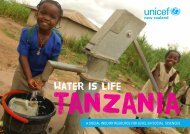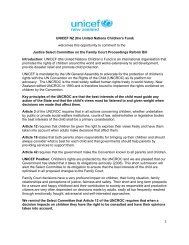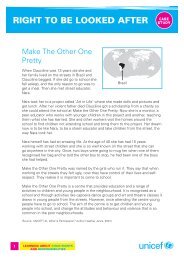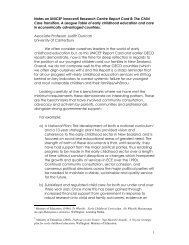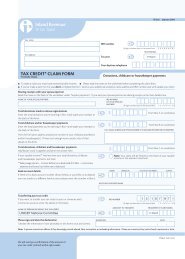Caught in the Crossfire pdf - Unicef
Caught in the Crossfire pdf - Unicef
Caught in the Crossfire pdf - Unicef
You also want an ePaper? Increase the reach of your titles
YUMPU automatically turns print PDFs into web optimized ePapers that Google loves.
Unit Plan<br />
Title of Unit: <strong>Caught</strong> <strong>in</strong> <strong>the</strong> <strong>Crossfire</strong><br />
Context: Children affected by conflict<br />
Year: 10<br />
Level: 5<br />
Sett<strong>in</strong>g: Global<br />
Perspective: Age<br />
Duration: 6-8 Periods<br />
Approach: Inquiry<br />
Achievement Objective<br />
Students will ga<strong>in</strong> knowledge, skills and experience to understand<br />
how people def<strong>in</strong>e and seek human rights.<br />
Learn<strong>in</strong>g Outcomes<br />
Students will:<br />
• Understand how <strong>the</strong> affect of war on children has led people to<br />
def<strong>in</strong>e and seek to meet children’s rights<br />
• Develop an empathy towards and an awareness of children<br />
who live without <strong>the</strong>ir basic rights be<strong>in</strong>g met<br />
• Be better empowered to assess and decide upon <strong>the</strong>ir own<br />
responses by study<strong>in</strong>g how o<strong>the</strong>rs respond to situations where<br />
children’s rights are compromised<br />
Learn<strong>in</strong>g Area<br />
Identity, Culture and Organisation<br />
Students learn about communities who experience conflict and how<br />
<strong>the</strong> changes to <strong>the</strong> function<strong>in</strong>g of <strong>the</strong>se societies dur<strong>in</strong>g time of crises<br />
affects children. They also learn about <strong>the</strong> role of organisations and<br />
<strong>in</strong>dividuals who seek human rights <strong>in</strong> this context and what <strong>in</strong>fluence<br />
<strong>the</strong>ir actions have on children impacted by conflict.<br />
(The Identity, Culture and Organisation learn<strong>in</strong>g area word<strong>in</strong>g from<br />
<strong>the</strong> NZ curriculum has been tailored to <strong>the</strong> context).<br />
Key Competencies<br />
Th<strong>in</strong>k<strong>in</strong>g – us<strong>in</strong>g creative and critical th<strong>in</strong>k<strong>in</strong>g to develop<br />
understand<strong>in</strong>g; take <strong>in</strong>formed action and make decisions through<br />
problem solv<strong>in</strong>g; and apply knowledge and research.<br />
Participat<strong>in</strong>g and Contribut<strong>in</strong>g – connect<strong>in</strong>g with o<strong>the</strong>rs and<br />
be<strong>in</strong>g able to contribute appropriately to <strong>the</strong> global community;<br />
understand<strong>in</strong>g <strong>the</strong> importance of rights, roles and responsibilities to<br />
<strong>the</strong> social, cultural and economic operation of society.<br />
Values<br />
Students will be encouraged to value:<br />
• Innovation, <strong>in</strong>quiry, and curiosity, by th<strong>in</strong>k<strong>in</strong>g critically, creatively<br />
and reflectively.<br />
• Integrity which <strong>in</strong>volves be<strong>in</strong>g honest, responsible and<br />
accountable and act<strong>in</strong>g ethically.<br />
• Community and participation for <strong>the</strong> common good.<br />
• Respect for <strong>the</strong>mselves, o<strong>the</strong>rs and human rights.<br />
Assessment<br />
Assignment – Students are required to communicate <strong>the</strong> concerns<br />
of children affected by conflict to <strong>the</strong> New Zealand public through<br />
<strong>the</strong> creation of a social network<strong>in</strong>g page or a magaz<strong>in</strong>e article. An<br />
assessment matrix is provided.<br />
Formative Assessment – Although not graded, mark<strong>in</strong>g <strong>the</strong> activities<br />
throughout <strong>the</strong> unit will provide an <strong>in</strong>dication of students’ current<br />
understand<strong>in</strong>g and highlight areas where more learn<strong>in</strong>g support<br />
is required. Of particular <strong>in</strong>terest may be <strong>the</strong> completed graphic<br />
organisers, students own def<strong>in</strong>itions of life sav<strong>in</strong>g, life susta<strong>in</strong><strong>in</strong>g<br />
and development, <strong>the</strong> completed activities from <strong>the</strong> lesson on new<br />
<strong>in</strong>novations for use <strong>in</strong> emergencies, and <strong>the</strong> attitude and response<br />
sheets from lesson six.<br />
Unit Review – A short multi-choice test at <strong>the</strong> end of <strong>the</strong> unit is<br />
designed to ascerta<strong>in</strong> if <strong>the</strong> unit’s learn<strong>in</strong>g outcomes have been<br />
achieved.<br />
Resources Required<br />
CD (see pocket on <strong>the</strong> <strong>in</strong>side cover of this resource)<br />
Access to computers and <strong>the</strong> <strong>in</strong>ternet<br />
Newspapers<br />
Data Projector (to show a power-po<strong>in</strong>t presentation)<br />
Us<strong>in</strong>g Language, Symbols, and Texts – us<strong>in</strong>g text and images to<br />
convey and learn ideas through an assignment and <strong>in</strong> class work, and<br />
us<strong>in</strong>g oral language through discussions and shar<strong>in</strong>g to help students<br />
convey and construct knowledge.<br />
Relat<strong>in</strong>g to O<strong>the</strong>rs – relate to o<strong>the</strong>rs by negotiat<strong>in</strong>g solutions <strong>in</strong> a<br />
group, listen<strong>in</strong>g to o<strong>the</strong>rs’ viewpo<strong>in</strong>ts and voic<strong>in</strong>g op<strong>in</strong>ions.


